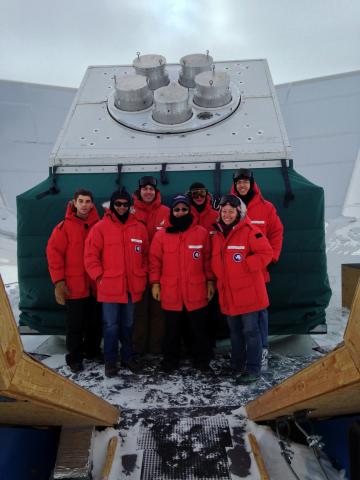Antarctica 2013--2014 Part 7: Science with Keck Array at the South Pole

The main science goal of our experiment is to measure faint microwave signals to help us better understand the Big Bang. Because the signals are so faint (equivalent to temperature fluctuations of less than 0.000001 degrees), we need incredibly sensitive detectors to find them. Furthermore, there are lots of stronger signals (e.g. from our own Galaxy) we have to reject in order to see the tiny ones from the beginning of the Universe. Therefore, most of our work here comes in two parts: upgrading our telescopes and characterizing how they respond to different types of signals.
Upgrades can be simple to understand although difficult to carry out. The most common upgrade is to install more sensitive, less-noisy detectors. Last year we replaced 45% of the detectors in Keck Array for this reason. The major upgrade this year was to replace two of the five telescopes to change their observing frequency. Previously all the Keck telescopes observed at 150 GHz (bluer light). This year we put in two 100 GHz (redder light) sensitive telescopes. The advantage of having multiple frequencies (colors) is that different astronomical objects have different colors. For example, the Galaxy is comparitively dim at 100 GHz, but the microwave background is bright at both frequencies. These differences help us tell whether we are finding microwaves from the Big Bang or microwaves from nearby objects.
Even the best telescopes need to be characterized. One major characterization goal this year is measuring the passband. The passband is the response of a telescope (including filters and detectors) to different frequencies. For example, a "100 GHz" sensitive telescope might respond to signals at 90 GHz or 110 GHz too. Depending on the application, different passbands might be desirable. We need to know what each telescope's passband is to fully understand the astronomical data. Another important characterization is the polarization angle. Since we are trying to measure polarization, we need to know what polarization direction each detector is sensitive to. For example, our detectors are designed to be pairs that are sensitive to polarizations 90 degrees apart. However, the detectors as built might be slightly rotated with respect to the designed angles. In order to answer these calibration questions, we build custom calibrators out of microwave sources, polarizing grids, heaters, coolers, antennas, etc. Each calibrator creates a known signal that we can use to test how the telescopes respond.
Next time, exploring the ice tunnels...
- Log in to post comments